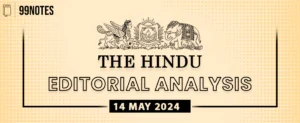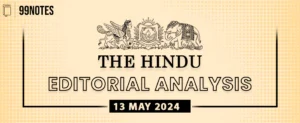Topic: GS1 – Geography – Effects of Climate change GS3 – Environment – Environmental pollution and degradation Understanding climate change as a human rights issue is crucial for UPSC due to its impact on governance and policy. |
| Context |
| The article discusses landmark legal rulings recognizing climate change as a human rights crisis, urging for rights-based climate action and legal accountability, particularly in India. |
European Court of Human Rights Ruling:
- The European Court of Human Rights found the Swiss Government guilty of violating the rights of senior women citizens from KlimaSeniorinnen, due to inadequate actions to curb emissions.
- This decision highlights the growing recognition of climate change as a human rights crisis globally.
- It underscores the failure of governments to protect vulnerable groups, particularly women, from the impacts of climate change.
Supreme Court of India’s Ruling:
- The Supreme Court of India ruled that individuals have the right ‘to be free from the adverse impacts of climate change’ under Articles 14 and 21 of the Indian Constitution.
- This establishes a legal precedent in India, recognizing climate change as a threat to fundamental rights, including the right to equality and the right to life.
Global Climate Crisis:
- The World Meteorological Organization’s State of the Global Climate Report for 2023 indicates record-breaking climate indicators, including the hottest year on record, ocean heat levels, sea level rise, Antarctic Sea ice loss, and glacier retreat.
- These alarming trends highlight the urgent need for action to address the escalating global climate crisis.
UN Secretary General’s Message:
- UN Secretary General António Guterres emphasises the critical situation on International Mother Earth Day 2024, stressing humanity’s destructive impact on nature and the urgent need to restore harmony with the environment.
India’s Climate Action and Vulnerability:
- India has made significant progress in decoupling emissions from economic growth, achieving two NDC targets ahead of schedule.
- However, the country remains highly vulnerable to climate change, with over 80% of its population living in districts at risk of climate-induced disasters.
Legal Accountability and Climate Action:
- The legal recognition of climate change impacts within the framework of constitutional fundamental rights sets a crucial precedent for holding governments accountable for climate action.
- This approach can accelerate climate action by fostering a more rights-based perspective and encouraging integrated approaches between government, private sector, and civil society.
Pathways for Accelerating Climate Action:
Adoption of Overarching Regulation:
- Implementing an overarching regulation on climate change can enhance state capacities, drive allocation of resources, and promote ambitious climate action in India.
- Such regulation can strengthen climate governance, facilitate knowledge exchange, and foster coherence in policies and actions across states and territories.
Inter-ministerial and Inter-sectoral Approaches:
- Building on initiatives like the One Health initiative, inter-ministerial and inter-sectoral approaches can promote collaboration between various stakeholders in addressing climate change.
- Integrating a rights-based approach into core operations of the private sector, such as circular economy practices, can have transformative impacts.
Empowering Citizen Groups and Civil Society Organizations:
- Leveraging the court’s observations can empower citizen groups and civil society organisations to foster rights-based dialogues on climate action.
- These dialogues can help reconcile potential tensions between conservation efforts and renewable energy targets, ensuring holistic solutions to environmental challenges.
Cultural and Legal Recognition of Nature’s Rights:
- Initiatives like declaring ‘Mother Nature’ a ‘living being’ by the Madras High Court in Tamil Nadu reflect the cultural and legal recognition of nature’s rights.
- Utilising such judgments and observations can help restore the health of Mother Earth and safeguard future generations from the impacts of climate change.
| India’s vulnerability to climate change |
India’s vulnerability: ● Highly Vulnerable Population: Over 80% of India’s population lives in districts at high risk of climate disasters like floods, droughts, and cyclones [CEEW Climate Change Vulnerability Index]. ● World Ranking: Ranked as the seventh most vulnerable country to climate extremes globally [Germanwatch 2022 Climate Risk Index]. ●Uneven Impacts: The southern states experience the most extreme weather events, while northeastern states face more frequent floods, and central/southern regions see harsher droughts [CEEW Climate Change Vulnerability Index]. Potential impact: ● Extreme Weather Events: India is susceptible to intensified cyclones, floods, and droughts due to climate change, impacting agriculture, infrastructure, and livelihoods. ● Water Stress: The Himalayan glaciers, a crucial water source, are melting rapidly, leading to increased water scarcity, especially in regions dependent on glacial runoff. ● Agricultural Impacts: Climate change disrupts monsoon patterns, affecting crop yields and food security for millions. Variability in rainfall patterns also leads to crop failures and loss of income. ● Health Risks: Rising temperatures exacerbate heatwaves and spread vector-borne diseases like dengue and malaria, posing significant health risks to vulnerable populations. ● Coastal Vulnerability: India’s long coastline faces threats from sea-level rise, causing erosion, saltwater intrusion, and displacement of coastal communities. ● Biodiversity Loss: Climate change threatens India’s rich biodiversity, including its forests, coral reefs, and mangroves, disrupting ecosystems and endangering species. ● Urban Challenges: Rapid urbanisation coupled with climate change increases the vulnerability of cities to heat stress, flooding, and water shortages, affecting millions of urban residents. |
PYQ: (UPSC civil services prelims 2017) Q.With reference to ‘Global Climate Change Alliance’, which of the following statements is/are correct? (2017) 1. It is an initiative of the European Union. 2. It provides technical and financial support to targeted developing countries to integrate climate change into their development policies and budgets. 3. It is coordinated by World Resources Institute (WRI) and World Business Council for Sustainable Development (WBCSD). Select the correct answer using the code given below: (a) 1 and 2 only (b) 3 only (c) 2 and 3 only (d) 1, 2 and 3 Ans: Option A
Mains: Q.1 Describe the major outcomes of the 26th session of the Conference of the Parties (COP) to the United Nations Framework Convention on Climate Change (UNFCCC). What are the commitments made by India in this conference? (250 words/15m) (UPSC CSE (M) GS-3 2021) Q.2 ‘Climate Change’ is a global problem. How will India be affected by climate change? How Himalayan and coastal states of India will be affected by climate change? (250 words/15m) (UPSC CSE (M) GS-3 2017) |
| Practice Question: Discuss the significance of recent legal rulings recognizing climate change as a human rights crisis, and its implications for governance and policy-making, with a focus on India. (150 Words /10 marks) |











